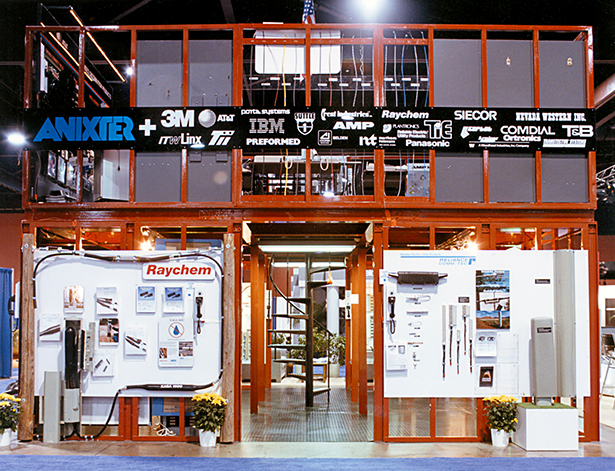Case Study: Trade Show Exhibit Applications Show Off Fiberglass Features
 Trade show exhibits with superstructures of fiberglass is a growing market that takes advantage of all the obvious features of fiberglass, including weight savings, ease of assembly, nonconductivity and durability. This 20' x 20' two-story Anixter Brothers, Inc. exhibit, with a superstructure entirely made of EXTREN® Series 525 fiberglass structural shapes, made its debut at the USTA Eastern Telecommunications Showcase in May, 1986 in Atlanta, Georgia. Fiberglass was selected over aluminum for this application not only because the fiberglass weighed less than the aluminum, but also because it was less expensive. Further savings were realized in transportation and assembly costs.
Trade show exhibits with superstructures of fiberglass is a growing market that takes advantage of all the obvious features of fiberglass, including weight savings, ease of assembly, nonconductivity and durability. This 20' x 20' two-story Anixter Brothers, Inc. exhibit, with a superstructure entirely made of EXTREN® Series 525 fiberglass structural shapes, made its debut at the USTA Eastern Telecommunications Showcase in May, 1986 in Atlanta, Georgia. Fiberglass was selected over aluminum for this application not only because the fiberglass weighed less than the aluminum, but also because it was less expensive. Further savings were realized in transportation and assembly costs.
| TECHNICAL DATA |
|---|
| Product: Fiberglass Superstructure for Trade Show Exhibit |
| Process: Pultrusion |
| Materials: EXTREN® Series 525 fiberglass reinforced polyester, fire retardant |
| Sizes: 20' x 20', 2-story Exhibit EXTREN® Structural Shapes used:
|
| For: J. T. Ryerson & Son, Inc. |
| User: Anixter Brothers, Inc. |
Constructed by Howard Displays of Chicago, Illinois, with fiberglass structural shapes and aluminum sandwiched plastic deck panels covered with carpeting, the unit is lightweight, very strong, and able to carry a live load 250 pounds per square foot on the second floor. The entire exhibit was shipped in one padded van to the exhibit site, set up in two days and required no riggers or lift equipment to assemble.
According to Howard Jacobs, President of Howard Displays, “The customer was very pleased with the exhibit and our staff found the fiberglass easy to work with. It worked much like wood as far as cutting and bonding goes and we could run the electrical conduit through the fiberglass without worry. I will continue to specify fiberglass structural shapes whenever possible.”
The longest floor span was 8' with the span design kept relatively short in order to utilize smaller fiberglass beams.